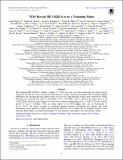| dc.contributor.author | Daylan, Tansu | |
| dc.contributor.author | Crossfield, Ian Jm | |
| dc.contributor.author | Ricker, George R | |
| dc.contributor.author | Vanderspek, Roland K | |
| dc.contributor.author | Seager, Sara | |
| dc.contributor.author | Glidden, Ana | |
| dc.contributor.author | Levine, Alan M | |
| dc.contributor.author | Günther, Maximilian N. | |
| dc.date.accessioned | 2022-08-11T20:22:23Z | |
| dc.date.available | 2021-09-20T18:22:16Z | |
| dc.date.available | 2022-08-11T20:22:23Z | |
| dc.date.issued | 2020-05 | |
| dc.date.submitted | 2020-03 | |
| dc.identifier.uri | https://hdl.handle.net/1721.1/132406.2 | |
| dc.description.abstract | © 2020. The American Astronomical Society. All rights reserved. The exoplanet HD 118203 b, orbiting a bright (V = 8.05) host star, was discovered using the radial velocity method by da Silva et al., but was not previously known to transit. Transiting Exoplanet Survey Satellite (TESS) photometry has revealed that this planet transits its host star. Nine planetary transits were observed by TESS, allowing us to measure the radius of the planet to be 1.136-0.028 +0.029 R J, and to calculate the planet mass to be 2.166-0.079 +0.074 M J. The host star is slightly evolved with an effective temperature of T eff=5683-85 +84 K and a surface gravity of log\,g=3.889 0.018-0.017. With an orbital period of 6.134985-0.000030 +0.000029 days and an eccentricity of 0.314 ± 0.017, the planet occupies a transitional regime between circularized hot Jupiters and more dynamically active planets at longer orbital periods. The host star is among the 10 brightest known to have transiting giant planets, providing opportunities for both planetary atmospheric and asteroseismic studies. | en_US |
| dc.language.iso | en | |
| dc.publisher | American Astronomical Society | en_US |
| dc.relation.isversionof | 10.3847/1538-3881/AB84F2 | en_US |
| dc.rights | Article is made available in accordance with the publisher's policy and may be subject to US copyright law. Please refer to the publisher's site for terms of use. | en_US |
| dc.source | The American Astronomical Society | en_US |
| dc.title | TESS Reveals HD 118203 b to be a Transiting Planet | en_US |
| dc.type | Article | en_US |
| dc.contributor.department | Massachusetts Institute of Technology. Department of Physics | en_US |
| dc.contributor.department | MIT Kavli Institute for Astrophysics and Space Research | en_US |
| dc.contributor.department | Massachusetts Institute of Technology. Department of Earth, Atmospheric, and Planetary Sciences | en_US |
| dc.contributor.department | Massachusetts Institute of Technology. Department of Aeronautics and Astronautics | en_US |
| dc.relation.journal | Astronomical Journal | en_US |
| dc.eprint.version | Final published version | en_US |
| dc.type.uri | http://purl.org/eprint/type/JournalArticle | en_US |
| eprint.status | http://purl.org/eprint/status/PeerReviewed | en_US |
| dc.date.updated | 2020-10-19T18:41:49Z | |
| dspace.orderedauthors | Pepper, J; Kane, SR; Rodriguez, JE; Hinkel, NR; Eastman, JD; Daylan, T; Mocnik, T; Dalba, PA; Gaudi, BS; Fetherolf, T; Stassun, KG; Campante, TL; Vanderburg, A; Huber, D; Bossini, D; Crossfield, I; Howell, SB; Stephens, AW; Furlan, E; Ricker, GR; Vanderspek, R; Latham, DW; Seager, S; Winn, JN; Jenkins, JM; Twicken, JD; Rose, M; Smith, JC; Glidden, A; Levine, AM; Rinehart, S; Collins, KA; Mann, AW; Burt, JA; James, DJ; Siverd, RJ; Günther, MN | en_US |
| dspace.date.submission | 2020-10-19T18:41:51Z | |
| mit.journal.volume | 159 | en_US |
| mit.journal.issue | 6 | en_US |
| mit.license | PUBLISHER_POLICY | |
| mit.metadata.status | Publication Information Needed | en_US |
